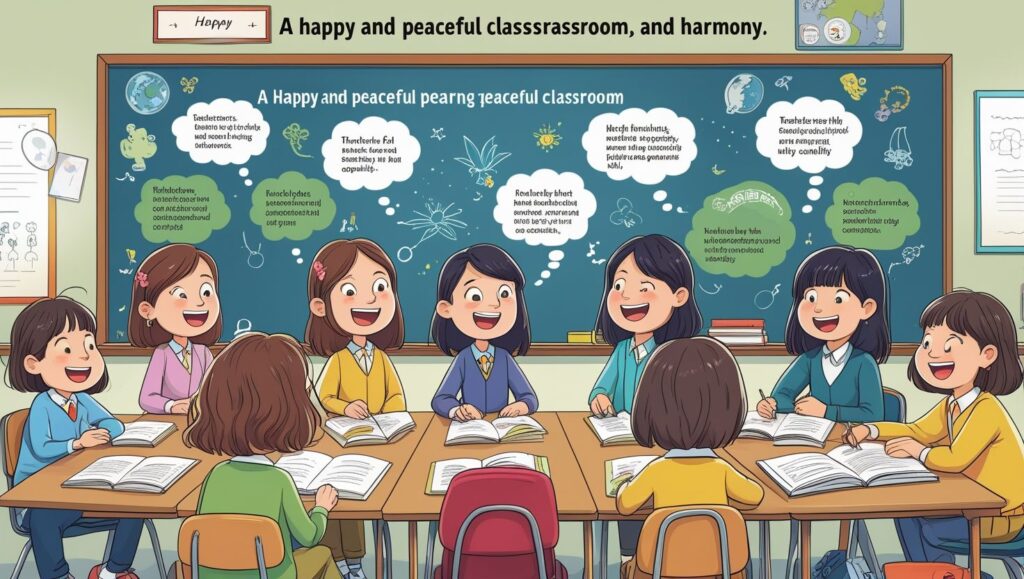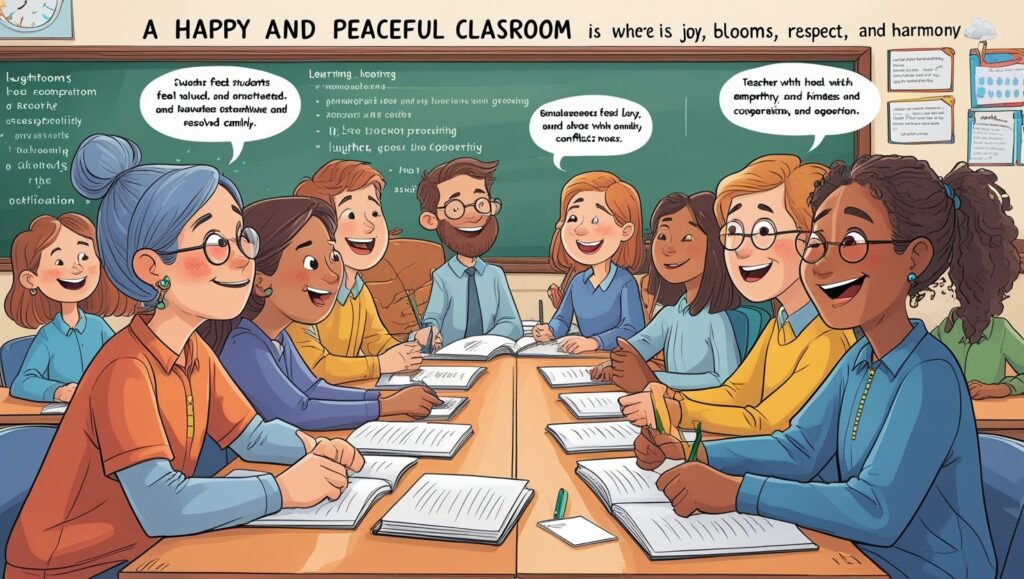Introduction
Happy and Peaceful Classroom Interactions, Happy and peaceful classrooms play a vital role in shaping the overall learning experience of students. They provide an environment where learners feel safe, respected, and motivated to engage actively in lessons. When classrooms operate in harmony, students experience less stress and more joy in learning. Teachers also benefit from such spaces, as they can focus on guiding learners instead of managing conflicts. Moreover, happy and peaceful interactions build strong relationships, which are crucial for both academic and social growth.
Furthermore, they encourage students to respect diversity, foster empathy, and enhance their communication skills. As a result, the classroom becomes a hub of positivity, where cooperation outweighs competition, and collaboration replaces isolation. In this way, a culture of mutual respect and understanding flourishes. Therefore, developing strategies for peaceful interactions is not just desirable but essential for effective education. This article explores how teachers and students can create and sustain happy and peaceful classroom interactions for better outcomes.
The Importance of Peaceful Interactions in Education
Peaceful interactions in classrooms are at the heart of meaningful education. Without them, even the best teaching methods lose their effectiveness. When students feel respected, they listen more attentively and participate more willingly. Teachers can also use their energy productively, focusing on instruction rather than conflict resolution. Additionally, peaceful classrooms promote emotional well-being, which directly influences learning outcomes. Studies suggest that students who learn in harmonious environments show higher motivation and better retention of knowledge. Furthermore, peaceful interactions help reduce anxiety, bullying, and classroom disruptions.
They create opportunities for students to develop essential social skills such as empathy, patience, and problem-solving. Teachers who prioritize peaceful interaction also model positive behaviors, which students are likely to replicate in their peer relationships. Thus, the importance of peaceful interactions extends beyond academics, contributing to the development of balanced individuals. Ultimately, they help prepare students for a society where cooperation, tolerance, and respect are crucial values.

Role of Teachers in Creating Happy Classrooms
Teachers play a central role in shaping the emotional climate of the classroom. Their words, attitudes, and teaching styles greatly influence how students interact with one another. Teachers who demonstrate kindness and patience encourage learners to adopt similar values. They can use effective communication techniques, such as active listening, to make students feel heard and valued. Furthermore, by setting clear expectations for respectful behavior, teachers reduce misunderstandings and conflicts.
Additionally, they can create lessons that promote collaboration instead of competition, allowing students to work together harmoniously. Teachers also need to be aware of diverse cultural and social backgrounds, ensuring that each learner feels included and respected. Importantly, when teachers celebrate small achievements, they motivate students to participate positively. By being role models, teachers help cultivate a classroom where happiness and peace are natural outcomes. Therefore, their proactive role is fundamental in fostering environments where students thrive academically and socially.
Building Respect and Empathy Among Students
Respect and empathy are the foundations of happy classroom interactions. When students respect one another, conflicts decrease, and collaboration becomes smoother. Teachers can encourage respect by establishing classroom norms that emphasize kindness, active listening, and fair treatment. For example, students can practice taking turns during discussions, ensuring that every voice is heard. Similarly, empathy is developed when learners are guided to understand the feelings of their peers.
Role-playing activities and group discussions can help students put themselves in others’ situations. Furthermore, teachers can use literature and storytelling to highlight different perspectives and experiences, thus fostering empathy. With time, these practices encourage students to treat their classmates with care and understanding. As a result, classrooms become safer spaces where everyone feels valued. Additionally, empathy reduces bullying and promotes inclusivity. By prioritizing respect and empathy, students learn to resolve conflicts peacefully. Consequently, peaceful and happy classroom interactions become part of their daily behavior.
Communication as a Tool for Harmony
Effective communication is one of the strongest tools for creating peaceful interactions. When students and teachers communicate clearly, misunderstandings are minimized, and trust grows. Teachers should model open, respectful communication by using polite language and listening attentively. Additionally, students should be taught the importance of expressing their ideas calmly and constructively. Classroom discussions, group projects, and peer feedback sessions can help strengthen communication skills.
Moreover, non-verbal communication such as gestures, eye contact, and tone of voice also plays an important role. Teachers can train students to be mindful of these cues to prevent unnecessary conflicts. Furthermore, conflict resolution strategies such as “I statements” (“I feel upset when…”) allow learners to express emotions without blaming others. This technique supports respectful dialogue and encourages understanding. With effective communication, students become confident speakers and attentive listeners. Ultimately, strong communication habits contribute significantly to a harmonious and cooperative learning atmosphere.

Classroom Activities that Encourage Cooperation
Cooperative activities are essential for building harmony among students. Group projects, collaborative games, and peer-learning tasks help learners understand the value of teamwork. When students work together toward common goals, they learn to share responsibilities and respect diverse perspectives. Teachers can design activities that require joint problem-solving, such as science experiments or group debates. Moreover, cooperative learning encourages active participation from all students, making learning more engaging.
Importantly, such tasks promote mutual support, as stronger students help weaker ones without judgment. Teachers can also rotate group members frequently, ensuring that every student gets an opportunity to interact with different peers. This practice reduces cliques and promotes inclusivity. Furthermore, cooperative activities enhance critical thinking and creativity, as students exchange unique ideas. Ultimately, they replace unhealthy competition with a sense of unity. By integrating cooperative learning strategies regularly, teachers can create happy and peaceful classroom interactions that benefit everyone.
Role of Classroom Environment in Promoting Peace
The physical and emotional environment of the classroom has a strong impact on interactions. A classroom that is clean, organized, and welcoming promotes positive behavior and reduces stress. Comfortable seating, bright colors, and proper lighting create a cheerful atmosphere that encourages learning. Additionally, displaying motivational posters and student artwork can boost confidence and happiness. Beyond the physical setup, the emotional climate also matters greatly.
A safe environment where students can express themselves freely without fear of judgment leads to peaceful interactions. Teachers must address bullying, favoritism, or negative behaviors quickly to maintain a supportive climate. Moreover, structured routines and consistent rules ensure stability, which helps reduce anxiety. When students feel secure and valued, they are more likely to interact kindly with their peers. Therefore, the classroom environment should be intentionally designed to balance order and warmth. Ultimately, a positive environment lays the foundation for peaceful and joyful learning experiences.
Conflict Resolution Strategies in Classrooms
Conflicts are natural in any group setting, but in classrooms, they must be addressed carefully. Teachers should equip students with conflict resolution strategies that encourage peace instead of aggression. For instance, teaching negotiation skills helps learners find solutions where both sides feel satisfied. Similarly, the use of peer mediation programs allows students to resolve issues among themselves with guidance. Additionally, teachers can encourage reflection by asking students to think about how their actions affect others.
Role-playing activities can also prepare learners for handling disagreements calmly. Importantly, teachers must remain neutral while facilitating conflict resolution, ensuring fairness. Moreover, introducing concepts like forgiveness and second chances helps reduce resentment. With these strategies, students learn to replace anger with understanding and hostility with cooperation. As a result, classrooms become safer and more harmonious. Thus, by prioritizing peaceful conflict resolution, teachers prepare students for positive relationships inside and outside school.
Benefits of Happy and Peaceful Interactions
The benefits of happy and peaceful interactions in classrooms are numerous. Academically, students perform better when they feel relaxed and supported. Their ability to focus improves, and they develop stronger problem-solving skills. Emotionally, peaceful classrooms reduce stress and anxiety, contributing to overall well-being. Socially, learners acquire valuable skills such as communication, empathy, and collaboration, which are essential for success in life.
Teachers also benefit from such environments, as they experience less stress and higher job satisfaction. Furthermore, peaceful interactions reduce classroom disruptions, making teaching more effective. They also prepare students to contribute positively to society by valuing diversity and respecting others. Additionally, happy classrooms foster lifelong love for learning, as students associate education with joy rather than fear. Importantly, the effects extend beyond the school years, as students carry these lessons into their personal and professional lives. Clearly, the benefits of fostering peaceful classrooms are long-lasting and transformative.

Conclusion
In conclusion, happy and peaceful classroom interactions are essential for building strong learning communities. They enhance academic achievement, emotional well-being, and social development. Teachers play a significant role by modeling kindness, promoting empathy, and maintaining an inclusive environment. Students, on the other hand, benefit greatly from learning respect, cooperation, and communication skills. Furthermore, classroom activities, conflict resolution strategies, and a supportive environment all contribute to peaceful interactions.
When harmony prevails, the entire learning process becomes more enjoyable and effective. Beyond education, these experiences prepare students to live responsibly in society by practicing tolerance and respect. Therefore, schools must prioritize the creation of classrooms where joy, peace, and learning go hand in hand. By doing so, we can cultivate not only better students but also better human beings who value harmony in every aspect of life. Truly, happy classrooms are the foundation of a brighter future.
References
- Johnson, D. W., & Johnson, R. T. (2020). Joining Together: Group Theory and Group Skills. Pearson.
- Noddings, N. (2015). The Challenge to Care in Schools: An Alternative Approach to Education. Teachers College Press.
- Pianta, R. C., Hamre, B. K., & Allen, J. P. (2012). Teacher-student relationships and engagement. In Handbook of Research on Student Engagement. Springer.
- Elias, M. J., & Schwab, Y. (2006). From compliance to responsibility: Social-emotional learning and classroom culture. Phi Delta Kappan, 88(4), 283–286.
- Jennings, P. A., & Greenberg, M. T. (2009). The prosocial classroom: Teacher social and emotional competence in relation to student and classroom outcomes. Review of Educational Research, 79(1), 491–525.
- Freiberg, H. J. (1999). School Climate: Measuring, Improving and Sustaining Healthy Learning Environments. Falmer Press.


This is such a valuable article! I really like how you’ve managed to explain the topic in a clear and practical way—it feels authentic and easy to relate to. Reading it gave me some new perspectives that I can actually apply. I’m especially interested in content like this because at meinestadtkleinanzeigen.de we’re running a classifieds and directory platform in Germany that connects people with services, businesses, and opportunities across many categories. Insights like yours remind me how powerful it is when knowledge and connections come together. Thanks for sharing—looking forward to more of your work!
Great article, thanks for sharing such valuable insights! I really appreciate the way you explained the topic so clearly and made it easy to understand. It’s rare to find content that is both informative and practical like this. By the way, I recently came across a helpful platform called profis-vor-ort.de — it connects people quickly with local experts and services in Germany. I think it could be a great resource for anyone interested in finding trustworthy professionals nearby. Keep up the great work, I’ll definitely be following your future posts!
dcek4k